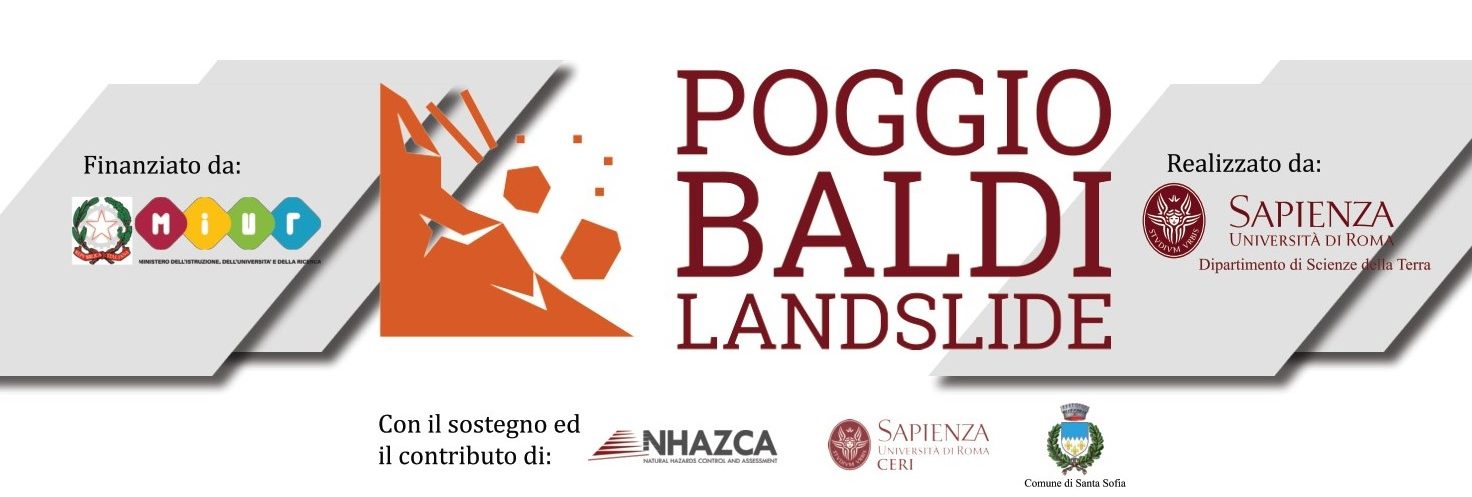Poggio Baldi Natural Laboratory
The Poggio Baldi landslide is one of the largest rock and debris phenomena in the Emilia-Romagna Apennines. From October 26, 2021 it becomes a real Experimental Permanent Monitoring Site where monitoring activities and advanced remote sensing techniques are merged in a Natural Laboratory.

News
What is the Lab
The Poggio Baldi laboratory is an experimental and permanent natural monitoring site for the homonymous landslide. The lab is managed by the Department of Earth Sciences of the Sapienza University of Rome and it is framed in the project “Dipartimento di Eccellenza per le Scienze della Terra” (Sapienza University of Rome – Years 2018-2022) funded by MIUR. The lab is also supported by NHAZCA Srl, start-up of the Sapienza University.
The lab employs the most advanced remote sensing tools in order to monitor the activity of the main rock scarp, which is often source of rockfalls, and the related debris talus at the toe. The permanent lab officially starts on 26 October 2021 with the installation of a fully-fledged, energy-indipendet wooden structure that allow the continuous monitoring 24 hours a day, remotely accessible and manageable.
The first monitoring activities date back to April 2015, when short-term geomorphological monitoring campaigns were initiated by the Department of Earth Science of Sapienza University with an annual basis. Over time, the lab has been supplied with more instruments as well as partners and sponsors who find the natural laboratory of the Poggio Baldi landslide the ideal place to test their experimental instruments for landslide assessment and monitoring.
What we do
Since 2015 at the Poggio Baldi Experimental Site, many researchers and leading companies in the production of geotechnical and geomatic monitoring instrumentation have been meeting annually with the technical and scientific community for live, in-field demonstrations of their technologies. Moreover, in the Poggio Baldi area a large number of surveys and investigations have been carried out using modern remote sensing techniques, in order to acquire as much information as possible about the the active gravitational processes. Specifically, the activities carried out were as follows:
- multi-temporal and multi-station surveys with Terrestrial Laser Scanner (TLS);
- surveys by Global Navigation Satellite System (GNSS);
- photogrammetric surveys by SAPR platform (Remotely Piloted Aircraft Systems);
- Gigapixel surveys by robotic head for camera;
- monitoring by Terrestrial SAR Interferometry (TInSAR).
Papers
DATE
TITLE
2023
Massi A.; Ortolani M.; Vitulano D.; Bruni V.; Mazzanti P. (Remote Sensing – MDPI)
2023
Robiati C.; Mastrantoni G.; Eyre M.; Coggan J.; Mazzanti P. (Land – MDPI)
2021
Esposito C.; Di Luzio E.; Baleani M.; Troiani F.; Della Seta M.; Bozzano F.; Mazzanti P. (Geomorphology– ELSEVIER)
2021
Mazzanti P.; Caporossi P.; Brunetti A.; Mohammadi F.I.; Bozzano F. (Landslides– Springer Nature)
2021
Romeo S., Cosentino A., Giani F., Mastrantoni G., Mazzanti P. (Sensors – MDPI)
2017
Experimental Landslide Monitoring Site of Poggio Baldi Landslide (Santa Sofia, N-Apennine, Italy)
Mazzanti, Paolo; Bozzano, Francesca; Brunetti, Alessandro; Caporossi, Paolo; Esposito, Carlo; Scarascia Mugnozza, Gabriele (Advancing Culture Of Living With Landslides– Springer Nature)
About us
The Department of Earth Sciences of Sapienza University of Rome, in collaboration with CERI and NHAZCA Srl founded the Poggio Baldi natural laboratory with a mission: testing innovative remote sensing monitoring tools in a challenging natural area and employ them for landslide hazard assessment.
Starting from 2015, several researchers and leading companies in manufacturing of geotechnical and geomatic monitoring equipment, have taken advantage of the experimental monitoring site to perform multi-temporal surveys by using different remote sensing techniques, such as Terrestrial Laser Scanning, Global Position System, Unmanned Aerial Vehicles, Photogrammetry, Digital Image Correlation, Terrestrial Interferometric SAR.
Our goal is to make the experimental landslide monitoring site of Poggio Baldi a proper fundamental standard natural laboratory of total-monitoring aimed at hydrogeological risk management and assessment.
Team
Paolo Mazzanti
Professor at the Department of Earth Sciences, “Sapienza” University of Rome and CEO of NHAZCA S.r.l., expert in innovative monitoring solutions in the field of remote sensing, promoter of the international IcGSM course on geotechnical and structural monitoring.
Gabriele Scarascia Mugnozza
Professor at the Department of Earth Sciences of the “Sapienza” University of Rome, founding partner of NHAZCA S.r.l., director of the CERI Research Centre and President of the National Major Risks Commission.
Francesca Bozzano
Professor at the Department of Earth Sciences of the “Sapienza” University of Rome, president and founding partner of NHAZCA S.r.l., member of the National Commission for Forecasting and Preventing Major Risks and of the INGV Board of Directors.
Gian Marco Marmoni
Researcher at the Department of Earth Sciences of Sapienza University of Rome with experience on geomechanical and thermal modelling of rock slopes.
Giandomenico Mastrantoni
Doctoral researcher belonging to the 36th cycle at the Department of Earth Sciences of “Sapienza” University of Rome and financed by the CERI research centre.
Antonio Cosentino
Industrial doctoral researcher belonging to the 36th cycle at the Department of Earth Sciences of “Sapienza” University of Rome and co-financed by Nhazca Srl, Start-Up of the same University.
Andrea Massi
Industrial doctoral researcher belonging to the 36th cycle at the Department of Physics of “Sapienza” University of Rome and co-financed by Nhazca Srl, Start-Up of the same University.
Giacomo Santicchia
Doctoral researcher belonging to the 37th cycle at the Department of Earth Sciences of “Sapienza” University of Rome.
Jagadish Kundu
Postdoctoral researcher at the Department of Earth Sciences, Sapienza University of Rome. An expert in rock mechanics and interseted in solving hill slope stability problems using physical, numerical and point cloud techniques.
Antonio Molinari
Former MSc graduate student at the Department of Earth Sciences of Sapienza University of Rome.








